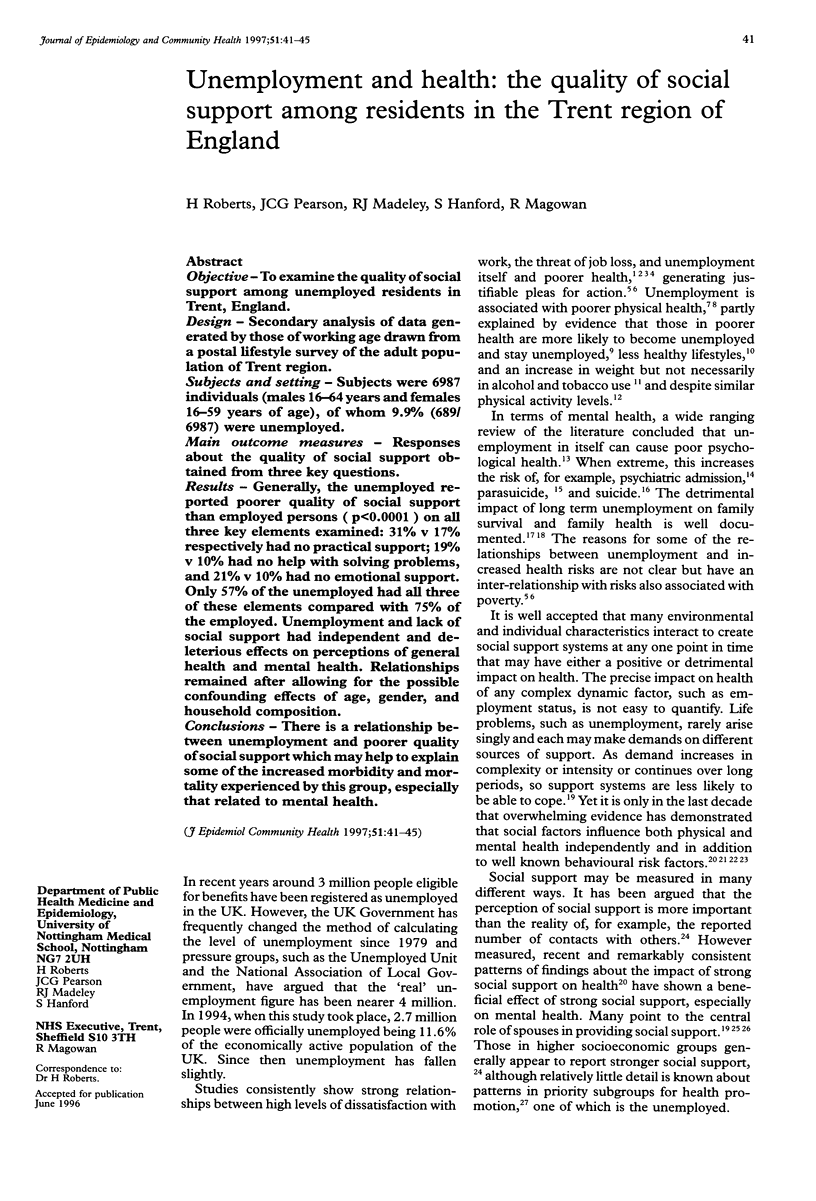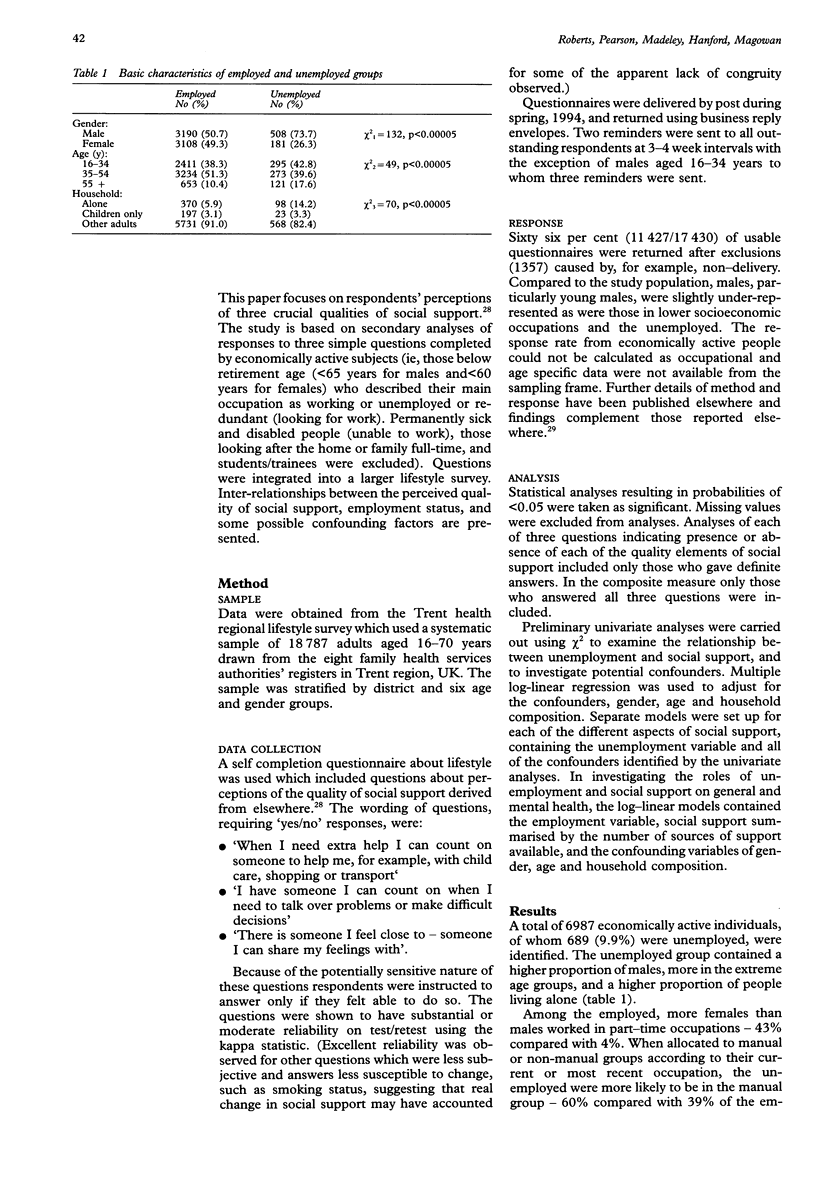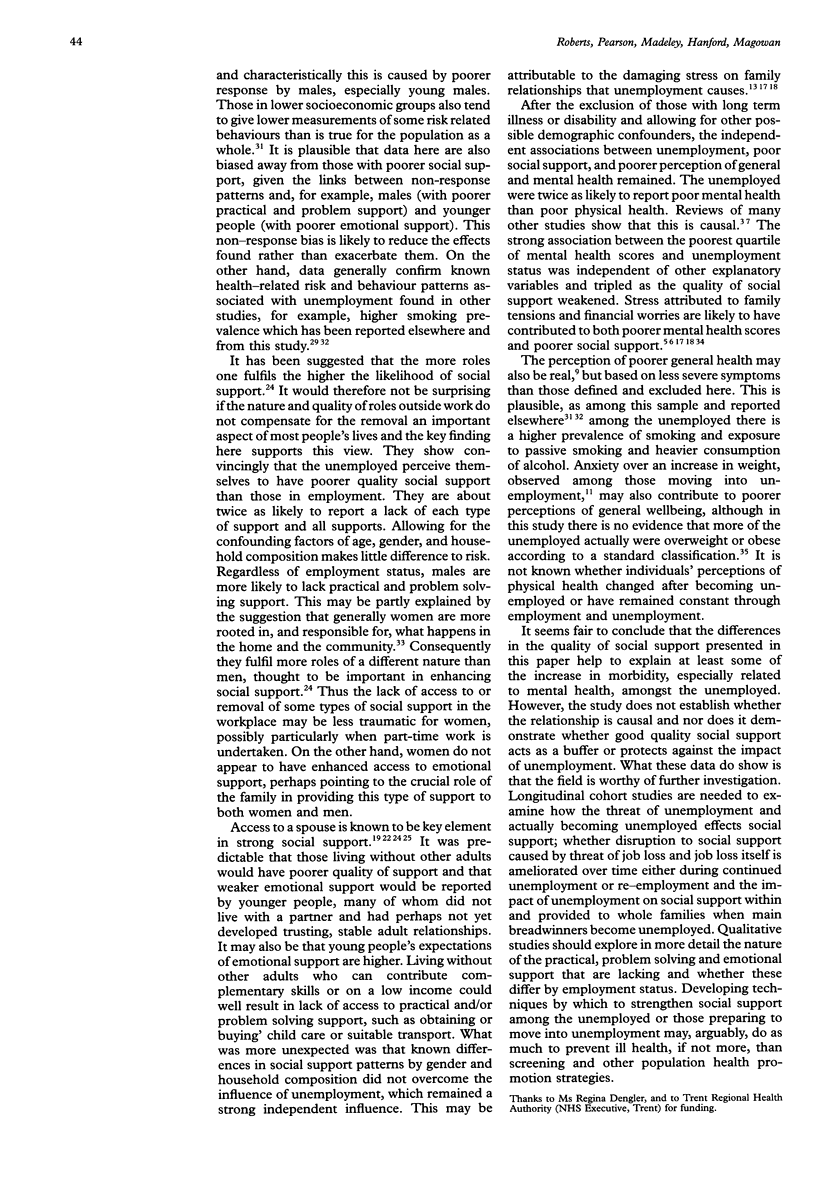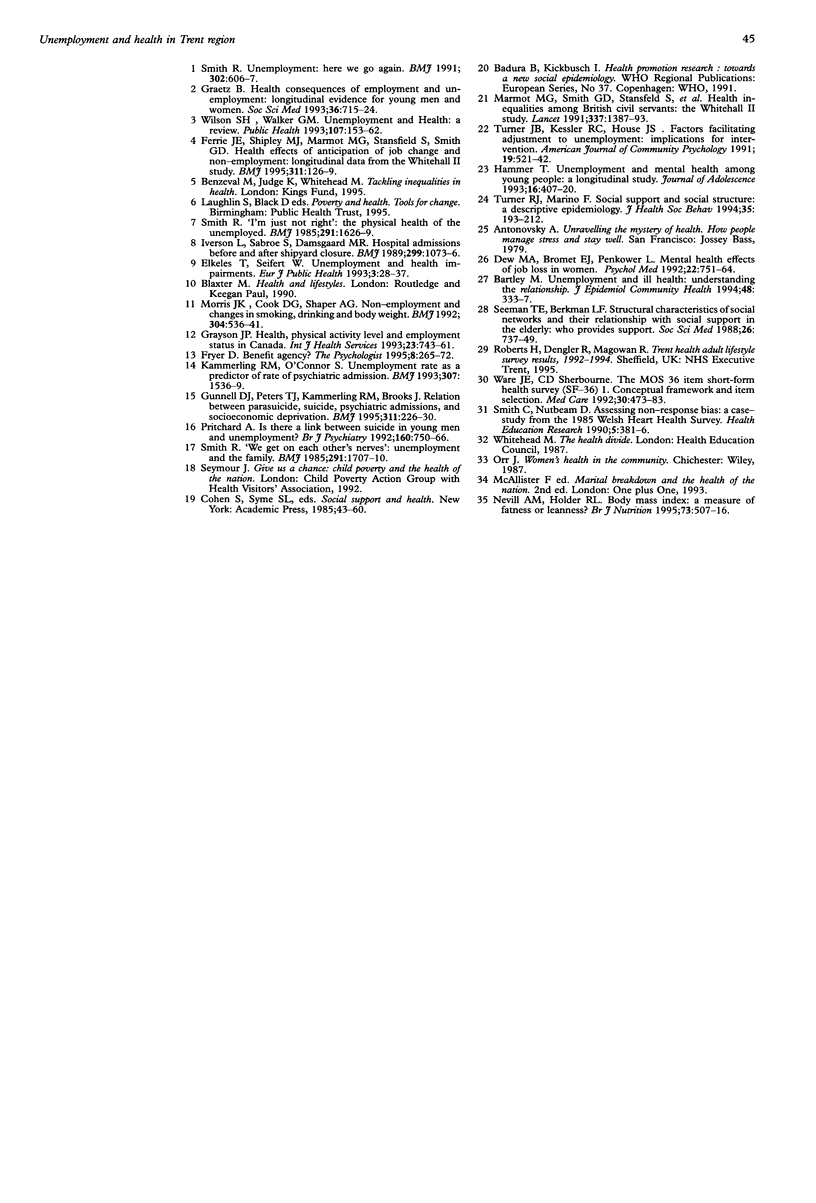Abstract
OBJECTIVE: To examine the quality of social support among unemployed residents in Trent, England. DESIGN: Secondary analysis of data generated by those of working age drawn from a postal lifestyle survey of the adult population of Trent region. SUBJECTS AND SETTING: Subjects were 6987 individuals (males 16-64 years and females 16-59 years of age), of whom 9.9% (689/6987) were unemployed. MAIN OUTCOME MEASURES: Responses about the quality of social support obtained from three key questions. RESULTS: Generally, the unemployed reported poorer quality of social support than employed persons (p < 0.0001) on all three key elements examined: 31% v 17% respectively had no practical support; 19% v 10% had no help with solving problems, and 21% v 10% had no emotional support. Only 57% of the unemployed had all three of these elements compared with 75% of the employed. Unemployment and lack of social support had independent and deleterious effects on perceptions of general health and mental health. Relationships remained after allowing for the possible confounding effects of age, gender, and household composition. CONCLUSIONS: There is a relationship between unemployment and poorer quality of social support which may help to explain some of the increased morbidity and mortality experienced by this group, especially that related to mental health.
Full text
PDF




Selected References
These references are in PubMed. This may not be the complete list of references from this article.
- Bartley M. Unemployment and ill health: understanding the relationship. J Epidemiol Community Health. 1994 Aug;48(4):333–337. doi: 10.1136/jech.48.4.333. [DOI] [PMC free article] [PubMed] [Google Scholar]
- Dew M. A., Bromet E. J., Penkower L. Mental health effects of job loss in women. Psychol Med. 1992 Aug;22(3):751–764. doi: 10.1017/s0033291700038198. [DOI] [PubMed] [Google Scholar]
- Graetz B. Health consequences of employment and unemployment: longitudinal evidence for young men and women. Soc Sci Med. 1993 Mar;36(6):715–724. doi: 10.1016/0277-9536(93)90032-y. [DOI] [PubMed] [Google Scholar]
- Grayson J. P. Health, physical activity level, and employment status in Canada. Int J Health Serv. 1993;23(4):743–761. doi: 10.2190/W5NR-A7A4-BX4A-T4F7. [DOI] [PubMed] [Google Scholar]
- Gunnell D. J., Peters T. J., Kammerling R. M., Brooks J. Relation between parasuicide, suicide, psychiatric admissions, and socioeconomic deprivation. BMJ. 1995 Jul 22;311(6999):226–230. doi: 10.1136/bmj.311.6999.226. [DOI] [PMC free article] [PubMed] [Google Scholar]
- Hammer T. Unemployment and mental health among young people: a longitudinal study. J Adolesc. 1993 Dec;16(4):407–420. doi: 10.1006/jado.1993.1033. [DOI] [PubMed] [Google Scholar]
- Iversen L., Sabroe S., Damsgaard M. T. Hospital admissions before and after shipyard closure. BMJ. 1989 Oct 28;299(6707):1073–1076. doi: 10.1136/bmj.299.6707.1073. [DOI] [PMC free article] [PubMed] [Google Scholar]
- Kammerling R. M., O'Connor S. Unemployment rate as predictor of rate of psychiatric admission. BMJ. 1993 Dec 11;307(6918):1536–1539. doi: 10.1136/bmj.307.6918.1536. [DOI] [PMC free article] [PubMed] [Google Scholar]
- Marmot M. G., Smith G. D., Stansfeld S., Patel C., North F., Head J., White I., Brunner E., Feeney A. Health inequalities among British civil servants: the Whitehall II study. Lancet. 1991 Jun 8;337(8754):1387–1393. doi: 10.1016/0140-6736(91)93068-k. [DOI] [PubMed] [Google Scholar]
- Morris J. K., Cook D. G., Shaper A. G. Non-employment and changes in smoking, drinking, and body weight. BMJ. 1992 Feb 29;304(6826):536–541. doi: 10.1136/bmj.304.6826.536. [DOI] [PMC free article] [PubMed] [Google Scholar]
- Nevill A. M., Holder R. L. Body mass index: a measure of fatness or leanness? Br J Nutr. 1995 Apr;73(4):507–516. doi: 10.1079/bjn19950055. [DOI] [PubMed] [Google Scholar]
- Pritchard C. Is there a link between suicide in young men and unemployment? A comparison of the UK with other European Community Countries. Br J Psychiatry. 1992 Jun;160:750–756. doi: 10.1192/bjp.160.6.750. [DOI] [PubMed] [Google Scholar]
- Seeman T. E., Berkman L. F. Structural characteristics of social networks and their relationship with social support in the elderly: who provides support. Soc Sci Med. 1988;26(7):737–749. doi: 10.1016/0277-9536(88)90065-2. [DOI] [PubMed] [Google Scholar]
- Smith R. "We get on each other's nerves": unemployment and the family. Br Med J (Clin Res Ed) 1985 Dec 14;291(6510):1707–1710. doi: 10.1136/bmj.291.6510.1707. [DOI] [PMC free article] [PubMed] [Google Scholar]
- Turner J. B., Kessler R. C., House J. S. Factors facilitating adjustment to unemployment: implications for intervention. Am J Community Psychol. 1991 Aug;19(4):521–542. doi: 10.1007/BF00937990. [DOI] [PubMed] [Google Scholar]
- Turner R. J., Marino F. Social support and social structure: a descriptive epidemiology. J Health Soc Behav. 1994 Sep;35(3):193–212. [PubMed] [Google Scholar]
- Ware J. E., Jr, Sherbourne C. D. The MOS 36-item short-form health survey (SF-36). I. Conceptual framework and item selection. Med Care. 1992 Jun;30(6):473–483. [PubMed] [Google Scholar]
- Wilson S. H., Walker G. M. Unemployment and health: a review. Public Health. 1993 May;107(3):153–162. doi: 10.1016/s0033-3506(05)80436-6. [DOI] [PubMed] [Google Scholar]


